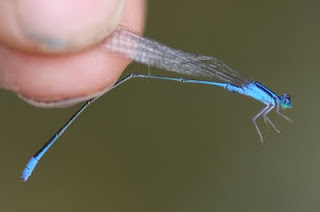Number: 135
Family: Coenagrionidae
Genus: Aciagrion
Species: Aciagrion hisopa
Common name(s): Slim Blue
Thai name(s): แมลงปอเข็มเรียวฮีสโซปา
Habitat: Exposed but weedy, natural uplands pond
Province(s) sighted: Khao Yai (Nakhorn Ratchasima).
Sightings (by me): Fairly common at above location
In flight (that I have seen): April-July (I assume longer)
Thai name(s): แมลงปอเข็มเรียวฮีสโซปา
Habitat: Exposed but weedy, natural uplands pond
Province(s) sighted: Khao Yai (Nakhorn Ratchasima).
Sightings (by me): Fairly common at above location
In flight (that I have seen): April-July (I assume longer)
One genus that always confuses me is Aciagrion. Many are almost identical and now Oleg Kosterin has cast doubt over my A. Occidentale post (and correctly so). The specimens I saw recently, though, are definitely something different (or so I hope!). This, I believe, is Aciagrion hisopa. Oleg Kosterin has looked at the photos and thinks it may be correct (either A. hisopa or a similar undescribed species).
The male
The male has a very slim ocular stripe and the ocular spots are large. Also S8-10 are solid blue.
Here, it gives you an idea of size... and the length of my horrible fingernails!
The female...
The female is very similar to the male, though the eyes were a more vivid green. This specimen was tucked away deep in the bushes.
Young female...
Very similar to the adult, but is more of a grey colour and it has dorsal markings on S8-9, which disappear with time.
The copula...
Here, in the 'wheel' position.
I saw 3-4 copula that day, but they flew away at the slightest movement. It took me a long time to get these photos. Here, the female is ovipositing onto rotting vegetation.
Though slightly dark, this photo shows a wheel from above.
Once again, many, many thanks to Oleg Kosterin for helping me clear up this genus somewhat.












For me, it is this species on your photos which looks like Aciagrion tillyardi as I know it from Cambodia (look at my comment to what you took for A. tillyaedi). However, it could be A. hisopa as well (although more than one species may be lumped under still unrevised A. hisopa). In fact, males of A. tillyardi are unmistakable by its curious stronly bifid upper appendages (rather conical in hisopa, azureum and others). Next time you meet these damsels, the blue and violet one, please, capture in hand and make a closeup photo of the abdomen tip. We will not be completely sure in the case of 'hisopa' but will be pretty shure in case of the true tillyardi.
ReplyDeleteIt is Oleg: For some reason it is no more possible to post here as an LJ user...
ReplyDeleteI am sorry for the previous comment, this cannot be A. tillyardi since it has an X-like black mark on S10 while this one has no. This is either A. hisopa indeed or a close undescribed species. I get the same in Cambodia in August and now am trying to digest this case.
Yet taking photo of the tips of male abdomens would be very helpful in case of Aciagrion.
Dennis, would you kindly permit me to use one or two of these your photos of this species in my paper concerning Cambodia? (Not yet sure in its layout).
ReplyDeleteOleg
Hi Oleg, of course you may use any photo you require!
ReplyDeleteEncontrei esta aqui no norte do Brasil em Castanhal no estado do Pará do 23/02/2024
ReplyDelete